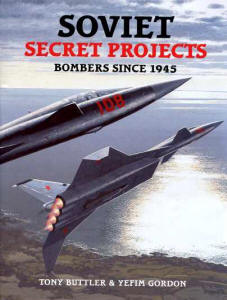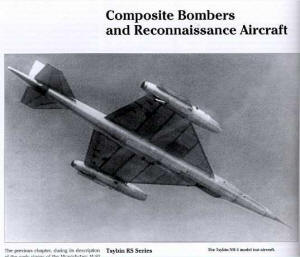|
Midland Publishing |
|
Soviet Secret Projects Volume 1 Bombers Since 1945 |
|
by Tony Buttler & Yefim Gordon |
|
Reviewed By Jim Pearsall, #2209 |
|
|
|
176 pages, with 200 b/w & color photos, plus line drawings, Hardbound MSRP: $44.95 USD Available from Specialty Press, who provided the review copy. 1-800-895-4585 (www.specialtypress.com) This comprehensive book is a continuation of a series of books by Midland Publishing (part of the very familiar Ian Allen publishing group). The series covers British, Luftwaffe, and now Soviet secret projects. I say this is a comprehensive book, because it not only covers those aircraft which never made it past the drawing board or prototype stages, but also gives the history of the development of better known types such as the Tu-4 “Bull”, the Su-24 “Fencer” and the Yak-38 “Forger”. Could this be because all Soviet aircraft projects were secret? Tony Buttler did the British Secret Projects books, and now teams with Yefim Gordon, who is emerging as the Soviet expert, rather as Rene Francillon did for Japanese aircraft. Gordon has a huge collection of aircraft photos, mostly of good quality, and appears to have either an encyclopedic knowledge of the Soviet aircraft industry, or sources our intelligence folks only dreamed of. The book is divided into chapters which trace the development of Soviet aircraft types. The chapter on heavy bombers traces development from the Junkers 287 to the Baade EF 131, whose drawing has the classification marking “GEHEIM” (Secret in German) ultimately to the Myasishchev M-4 “Bison” and the Tu-95 “Bear” production aircraft, and several follow-on projects which never got past the prototype stage. The Baade OKB was ultimately returned to Germany, and became VEB, which continued to design Junkers aircraft. A modeler who is interested in jet aircraft and wants to do a real jaw dropping scratch built or conversion project could find this book a truly indispensable reference. Each project has 3-view line drawing which give the outline and basic shapes of the aircraft, plus either photos of the prototype, pre-prototype manufacturer’s models, artist’s concept of what the aircraft would look like, or photos of the operational aircraft. There are also photos of fine models by George Cox which illustrate some of the projects which never got very far off the drawing board. The text is both well written and interesting, and “tells some tales” about what really went on inside the Soviet aircraft industry. The story of the Tsybin RS series is one I found particularly interesting. |
|
The Tsybin OKB was new in the 1950s, and came up with a proposal for a slim supersonic aircraft to deliver the new thermonuclear weapon (H-bomb). The Kremlin thought it looked like a winner, and authorized further development. The original concept of a parasite bomber with ram jets at the wing tips eventually evolved into a stand alone aircraft using afterburning turbofan engines. Although a prototype was built, it could never prove its worth, as Andrei Tupolev put pressure on the Tumansky engine works to produce the engine for his project, leaving Tsybin’s project without a viable power plant. Tsybin’s OKB was merged with Myasishchev’s, and Tsybin went on to work on the Soyuz project. I had seen pictures of this aircraft before, but this is the first time I’ve seen any explanation for why it never got past the prototype stage. My thanks to Specialty Press for providing this review copy. |
|
Information, images, and all
other items placed electronically on this site |

